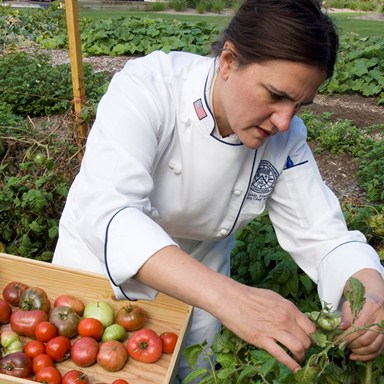1. Action in adult beverages. As Americans decide they’re once again ready to celebrate, we’ll be seeing lots of action in “Mad Men”-style retro cocktails, high-cachet gin and bourbon, craft beers and punch (including sangria). Look for cocktails with herbal and floral ingredients; “skinny” cocktails; even more adult beverages in fast-casual eateries to set them apart from traditional limited-service competitors.
2. Beyond bricks and mortar. Food trucks, facilitated by social media that notify foodies of their whereabouts, were an L.A. and Manhattan fad a year ago; now they’re proliferating around the country. “Land based” restaurants are using food trucks as brand extensions and catering aids; food-truck districts and “rodeos” are starting to appear; regulatory agencies are scrambling to keep up. Also unmooring restaurants from their traditional street corners: temporary or seasonal pop-up eateries and kiosks.
3. Farmers as celebrities. Once, it was all about celebrity operators; then star chefs rose to prominence. Now, the back-to-the-source mentality sends farmers and producers into the spotlight. Restaurants will feature their celebrity suppliers by offering special menus, inviting them to comment on blogs, even hosting visits. More often, farmers and artisans will be saluted in highly detailed menu descriptions. More attention to the supply chain also means more attention to food safety and product traceability as well as local sourcing.
4. Social media and technology: evolutionary spurt. We’ll see constant changes in applications for marketing and operations in 2011. Kiosk ordering, wine lists on iPads, tableside payment systems—which technologies will revolutionize operations? Couponing Web sites and location-based social media will grow while the apps fad will continue to evolve and face new competition from developing formats and technologies. Front-of-house and back-of-house technology and social media are evolving so fast that rewards and risks are high—but the biggest risk of all is failure to innovate.
5. Korean and beyond. The Korean taco—an only-in-America synthesis of Korean-style fillings and a Mexican format—signals the rise of Korean barbecue and Korean food in general; multicultural tacos with world ingredients, sometimes in surprising combinations; and portable street food and small plates from around the planet.
6. Frugality fatigue. Penny-pinching was a novelty when the recession began; now it’s gotten old. Anyone who can afford it will dip back into luxury dining in 2011. Look for flashy high-end restaurants and some extravagant, indulgent specials even on staid menus. Meanwhile, the middle class will gravitate to reasonably priced but high-experience-value, thrill-a-minute concepts with memorable menus. Pricey full-service concepts will continue to push bar menus, bringing in new customers at a lower price point, and gastropubs will proliferate.
7. How low can you go? Consumers will continue to demand price deals everywhere they eat. As food-input prices heat up next year, sustaining the bottom line will continue to be a crucial issue for operators. Look for more restructuring of price deals—for example, “everyday low price” positioning favored by retailers.
8. Carefully calibrated brand action. As the restaurant industry emerges from recession and capital spending picks up, we’ll see more fast-casual brand extensions by full-service restaurants and even non-restaurant brands; more ultra-niche eateries with narrowly focused menus and high-concept ambiance; investment in brand refreshes and remodels instead of unit growth. What new units we’ll see will be smaller, sustainably built, with more efficient layouts, often in nontraditional locations.
9. Back to our roots. The durable hunger for comfort food develops an appetite for homestyle Southern fare, from grits to seafood; retro Italian, including meatballs; gourmet donuts and popsicles for dessert; family-style service formats and family-size portions that would look right at home in a Norman Rockwell print.
10. New competition from c-stores. Retailers have been encroaching on restaurant turf for some time, but now the hottest action is among convenience-store operators upgrading their foodservice, where margins are 40% to 60% instead of the 5% typical for gas. Consumers are responding positively to upgraded offerings, variety and ambiance.
11. Healthful vs. indulgent: the little angel says one thing, the little devil another. As federal menu-labeling requirements take effect in 2011, the issue of healthful vs. indulgent fare—on the menu and in menu descriptions—gets complicated. Look for more items and detailed descriptions on “healthy” menus—including gluten-free fare as well as more “under x calories” items. Limited-time offers (including seasonal fare) will trend up, not only because they attract attention, but also because they don’t require posting nutrition data that consumers would rather not know. “Eating a little better” will translate into menu modifications such as slightly-lower-sodium, slightly-more-glamorous sea salt; “eating better some of the time” will lead to more innovations like “Meatless Mondays.”
Photo: Chef-instructor Heidi Hedeker of Kendall College, Chicago, cultivates heirloom tomatoes from Kendall’s organic garden for use in teaching in the college’s three dining outlets.
 Korean tacos, Southern comfort and “frugality fatigue” are among the leading restaurant trends predicted by Technomic for next year.
Korean tacos, Southern comfort and “frugality fatigue” are among the leading restaurant trends predicted by Technomic for next year.